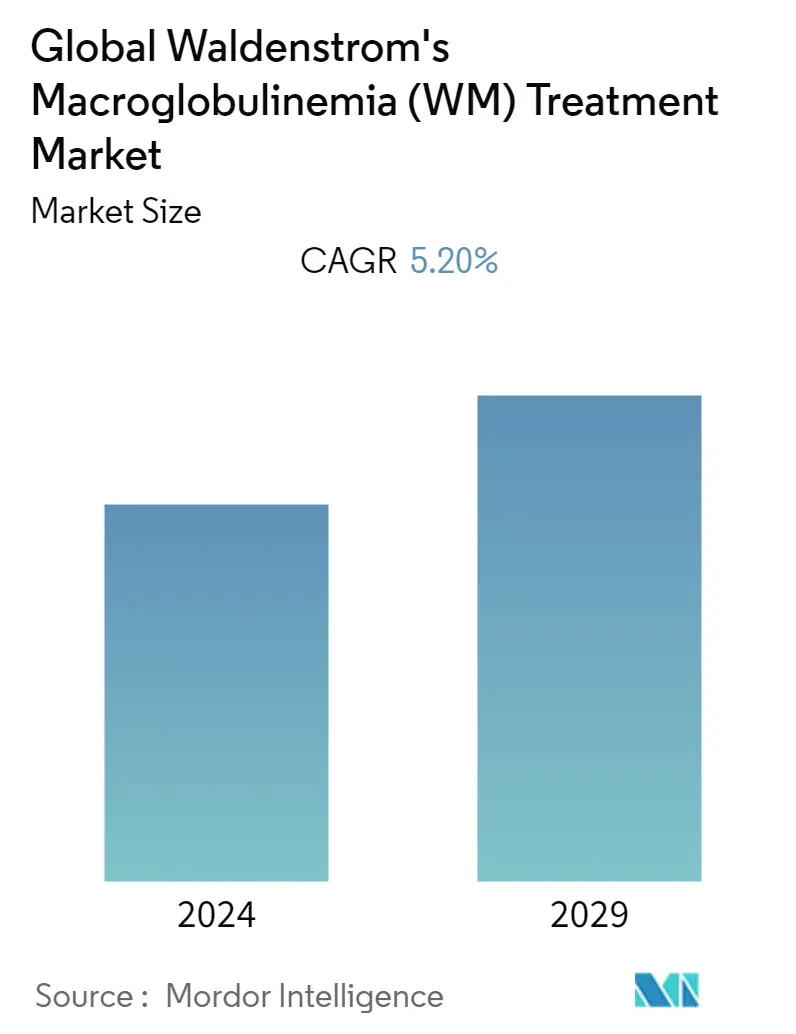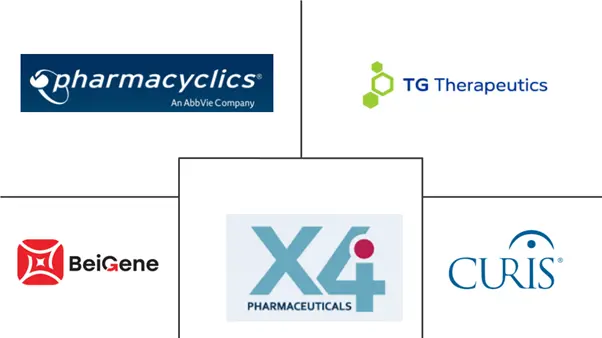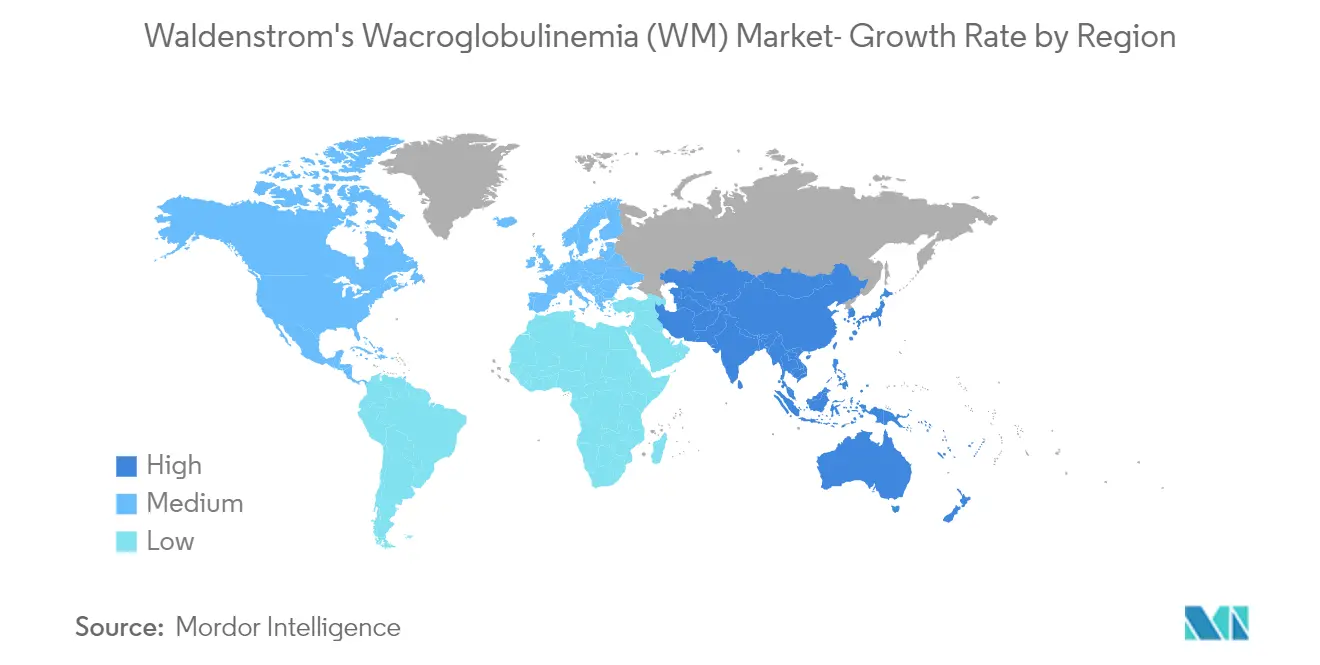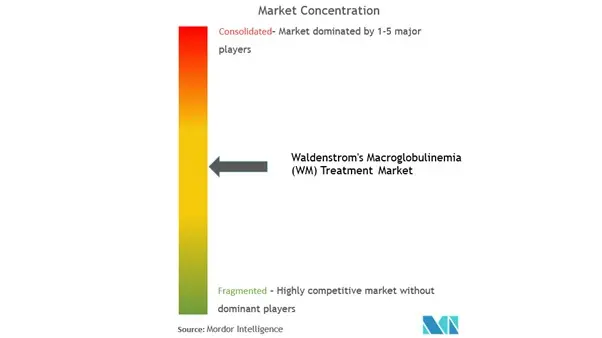Waldenstrom Macroglobulinemia Market Size

| Study Period | 2019 - 2029 |
| Base Year For Estimation | 2023 |
| Forecast Data Period | 2024 - 2029 |
| CAGR | 5.20 % |
| Fastest Growing Market | Asia-Pacific |
| Largest Market | North America |
Major Players
*Disclaimer: Major Players sorted in no particular order |
Waldenstrom Macroglobulinemia Market Analysis
Waldenstrom's Macroglobulinemia (WM) treatment market is anticipated to expand at a CAGR of 5.2% during the forecast period (2022-2027).
The worldwide health crisis of COVID-19 has affected the healthcare industry including its operations, commercial sales, regulatory interactions and inspections, and clinical trial recruitment and participation. COVID-19 has resulted in significant governmental measures being implemented to control the spread of the virus, including quarantines, travel restrictions, social distancing, and business shutdowns. Additionally, the commercial or clinical supply of the medicines and drug candidates has also been impacted due to the shutdown of the company's, or our third-party manufacturing facilities, distribution channels, and transportation systems, or shortages of raw materials and drug products which has reduced the company's revenue. For instance, AbbVie reported a 12.4% decrease in the net revenue generated by Imbruvica, used for waldenstrom's macroglobulinemia, in 2020 as compared to 2019.
The increasing prevalence and incidence of cases of waldenstrom's macroglobulinemia and increasing drug approvals by the regulatory bodies are escalating the growth of the market. The growth of the market is attributed to the increasing development of targeted and combination therapies across the globe. Furthermore, the rising geriatric population is expected to propel market growth. For instance, according to the statistics published by MedlinePlus genetics, it was observed that around 1,000 - 1,500 people are diagnosed with waldenstrom's macroglobulinemia (WM) each year in the United States, and is highest among individuals aged 60-79 years with an incidence rate of 3.4 per million among men and 1.7 per million among women in the United States. In addition, waldenstrom is predominantly affecting Caucasians.
Growing awareness about waldenstrom macroglobulinemia in low and middle-income countries, development of new diagnostic methods, rise in the need for novel therapies, and a constant number of clinical trials and heavy investments by the pharmaceutical companies and the government, can create remunerative opportunities and are speculated to bolster the market growth in the foreseeable future. For instance, in Nov 2020 AstraZeneca initiated a Phase II trial of bendamustine, rituximab, and the second-generation BTK Inhibitor Acalabrutinib in previously untreated waldenstrom's macroglobulinemia patients which is expected to complete by 2030. Bristol-Myers Squibb developing a Dasatinib drug in patients with waldenstrom macroglobulinemia (WM) progressing on Ibrutinib is under Phase 1 trial and is expected to be complete by 2024. BeiGene's Brukinsa, Abbvie's Imbruvica, and Gilead's ibrutinib are the approved drugs that are being prescribed to the patients. Takeda has the highest number of completed clinical trials for waldenstrom's macroglobulinemia.
However, the Inadequate accessibility of disease-specific treatment and unmet needs including lack of curative therapies, high treatment cost, dearth of skilled workers, and strict safety guidelines are projected to impede the growth of the market.
Waldenstrom Macroglobulinemia Market Trends
This section covers the major market trends shaping the Waldenstrom Macroglobulinemia Market according to our research experts:
Targeted Therapy Segment Expects to Register a High CAGR in the Forecast Period
The targeted therapy segment is expected to hold the largest share in this market segment. It is considered an is emerging pharmacotherapy for cancer. It is aimed at the disease blocking the growth and spread of cancer cells while minimizing the off-target side effects to the healthy/ normal cells. This leads to its higher adoption among other drugs, leading to its dominance in the market. Targeted therapy for waldenstrom macroglobulinemia includes monoclonal antibodies. For instance, anti-CD20 antibodies include obinutuzumab (Gazyva), ofatumumab (Arzerra), and rituximab-abbs (Truxima), Ibrutinib, Bortezomib (Velcade) are mostly used targeted therapy drugs for waldenstrom macroglobulinemia. According to the data published by National Cancer Institute, it has been observed that the targeted therapy agents, such as Imbruvica, Velcade, and Kyprolis, have shown improved treatment outcomes.
Furthermore, rising the number of pipeline candidates and an increased number of drug approvals are anticipated to propel the growth of this segment in the forecast period. For instance, according to ClinicalTrial.gov, 318 clinical studies are conducted by Institutes in collaboration with companies, 285 completed clinical studies, and 96 studies are either terminated, suspended, or withdrawn. In addition, Curis, X4, InnoCare, Ascentage, and Cellectar have 1 clinical trial in waldenstrom's macroglobulinemia disease.
Moreover, targeted therapy is being evaluated in COVID-19 treatment. Thus, encouraging clinicians to pursue targeted therapy agents during the pandemic is likely to create opportunities during the forecast period.

North America Dominates the Market and Expects to do Same in the Forecast Period
North America dominates waldenstrom's macroglobulinemia (WM) treatment market due to the rise in the incidence and prevalence of the disease coupled with new product launches in this region is responsible for the dominance of the market and continues to hold a health share in the market in the foreseeable period. As per the statistics provided by NORD (National Organization for Rare Disorders), waldenstrom's macroglobulinemia is affecting about 1 in 3.4 million American men and about half that number of American women. According to the data published by National Organization for Rare Disorders, it has been observed that the incidence of waldenstrom's macroglobulinemia is estimated to be about 5 per 1,000,000 people over the age of 50. Increasing research and development activities by the key players and the increased incidence of waldenstrom macroglobulinemia in the region are driving the growth of the market. Furthermore, the presence of major cancer foundations and increasing government grants to the medical institution, and growing awareness about the disease are also contributing to the growth of the market. Furthermore, the accessibility of medical resources will further boost the growth of waldenstrom's macroglobulinemia (WM) treatment market in the region during the forecast period. Many organizations that are supporting this disease are the American Society Center, International waldenstrom's macroglobulinemia Foundation (IWMF), and Lymphoma Research Foundation.

Waldenstrom Macroglobulinemia Industry Overview
The Waldenstrom's Macroglobulinemia (WM) treatment market is moderately competitive and consists of several major players. In terms of market share, few major players currently dominate the market. With the rising patient awareness levels and high prevalence of diseases, and a rising number of therapies and drugs, few other smaller players are expected to enter the market in the coming years. Some of the major players of the market include BeiGene, Curis, Inc., X4 Pharmaceuticals, TG Therapeutics, Pharmacyclics LLC.
Waldenstrom Macroglobulinemia Market Leaders
-
BeiGene
-
TG Therapeutics, Inc.
-
Curis, Inc.
-
X4 Pharmaceuticals, Inc.
-
Pharmacyclics LLC
*Disclaimer: Major Players sorted in no particular order

Waldenstrom Macroglobulinemia Market News
In Jan 2022, BeiGene announced the acceptance of its sNDA application in China for Brukinsa for the treatment of waldenstrom's macroglobulinemia (WM).
In August 2021, the Food and Drug Administration approved zanubrutinib (Brukinsa, BeiGene) for adult patients with waldenstrom's macroglobulinemia (WM).
In April 2021, Zydus Cadila announced the approval, of its first abbreviated new drug application, from the United States Food and Drug Administration (FDA), to market its ibrutinib generics in North America for the treatment of waldenstrom's macroglobulinemia (WM).
In Jan 2021, Cellectar Biosciences announced the approval from the United States Food and Drug Administration (FDA) for initiating a pivotal trial for CLR 131 in waldenstrom's macroglobulinemia (WM).
Waldenstrom Macroglobulinemia Market Report - Table of Contents
1. INTRODUCTION
- 1.1 Study Assumptions and Market Definition
- 1.2 Scope of the Study
2. RESEARCH METHODOLOGY
3. EXECUTIVE SUMMARY
4. MARKET DYNAMICS
- 4.1 Market Overview
-
4.2 Market Drivers
- 4.2.1 Growing Burden of Target Diseases
- 4.2.2 Development and Commercialization of effective Product
-
4.3 Market Restraints
- 4.3.1 Huge cost of treatment and lack of skilled persons
-
4.4 Porter's Five Force Analysis
- 4.4.1 Threat of New Entrants
- 4.4.2 Bargaining Power of Buyers/Consumers
- 4.4.3 Bargaining Power of Suppliers
- 4.4.4 Threat of Substitute Products
- 4.4.5 Intensity of Competitive Rivalry
5. MARKET SEGMENTATION
-
5.1 By Treatment Types
- 5.1.1 Plasmapheresis
- 5.1.2 Targeted therapy
- 5.1.3 Chemotherapy
- 5.1.4 Others
-
5.2 Geography
- 5.2.1 North America
- 5.2.2 Europe
- 5.2.3 Asia-Pacific
- 5.2.4 Middle East and Africa
- 5.2.5 South America
6. COMPETITIVE LANDSCAPE
-
6.1 Company Profiles
- 6.1.1 Johnson & Johnson Services, Inc.
- 6.1.2 AbbVie Inc.
- 6.1.3 Takeda Pharmaceutical Company Limited
- 6.1.4 BeiGene
- 6.1.5 AstraZeneca
- 6.1.6 Cellectar Biosciences, Inc
- 6.1.7 TG Therapeutics
- 6.1.8 Curis, Inc.
- 6.1.9 X4 Pharmaceuticals
- 6.1.10 InnoCare
- 6.1.11 Ascentage Pharma
- 6.1.12 Pharmacyclics LLC
- *List Not Exhaustive
7. MARKET OPPORTUNITIES AND FUTURE TRENDS
** Subject To AvailablityWaldenstrom Macroglobulinemia Industry Segmentation
As per the scope of the report, waldenstrom macroglobulinemia, also known as lymphoplasmacytic lymphoma, is an indolent subtype of non-Hodgkin lymphoma that originates in the bone marrow and starts producing abnormal white blood cells which hinder the normal functioning of the body and causes major complications. The major factor responsible for developing this disorder is the release of a hormone called interleukin (IL-6) from dendritic cells which aids in the growth of plasmacytoid lymphocytes.
It is suspected that the treatment options are bound to improve shortly, albeit at the cost of making its management increasingly complex. The Global Waldenstrom's Macroglobulinemia (WM) Treatment Market is segmented by treatment type (plasmapheresis, targeted therapy, chemotherapy, and Others) and geography (North America, Europe, Asia-Pacific, Middle East and Africa, South America). The report offers the value (in USD million) for the above segments. The market report also covers the estimated market sizes and trends for 17 countries across major regions globally.
| By Treatment Types | Plasmapheresis |
| Targeted therapy | |
| Chemotherapy | |
| Others | |
| Geography | North America |
| Europe | |
| Asia-Pacific | |
| Middle East and Africa | |
| South America |
Waldenstrom Macroglobulinemia Market Research FAQs
What is the current Global Waldenstrom's Macroglobulinemia (WM) Treatment Market size?
The Global Waldenstrom's Macroglobulinemia (WM) Treatment Market is projected to register a CAGR of 5.20% during the forecast period (2024-2029)
Who are the key players in Global Waldenstrom's Macroglobulinemia (WM) Treatment Market?
BeiGene, TG Therapeutics, Inc., Curis, Inc., X4 Pharmaceuticals, Inc. and Pharmacyclics LLC are the major companies operating in the Global Waldenstrom's Macroglobulinemia (WM) Treatment Market.
Which is the fastest growing region in Global Waldenstrom's Macroglobulinemia (WM) Treatment Market?
Asia-Pacific is estimated to grow at the highest CAGR over the forecast period (2024-2029).
Which region has the biggest share in Global Waldenstrom's Macroglobulinemia (WM) Treatment Market?
In 2024, the North America accounts for the largest market share in Global Waldenstrom's Macroglobulinemia (WM) Treatment Market.
What years does this Global Waldenstrom's Macroglobulinemia (WM) Treatment Market cover?
The report covers the Global Waldenstrom's Macroglobulinemia (WM) Treatment Market historical market size for years: 2019, 2020, 2021, 2022 and 2023. The report also forecasts the Global Waldenstrom's Macroglobulinemia (WM) Treatment Market size for years: 2024, 2025, 2026, 2027, 2028 and 2029.
Global Waldenstrom's Macroglobulinemia (WM) Treatment Industry Report
Statistics for the 2024 Global Waldenstrom’s Macroglobulinemia (WM) Treatment market share, size and revenue growth rate, created by Mordor Intelligence™ Industry Reports. Global Waldenstrom’s Macroglobulinemia (WM) Treatment analysis includes a market forecast outlook to 2029 and historical overview. Get a sample of this industry analysis as a free report PDF download.



